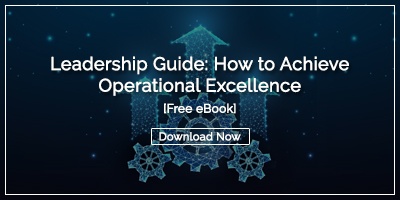
Achieving operational excellence means skillfully managing organizational processes and resources to deliver top-notch results. It's about continually refining internal operations to elevate customer satisfaction, cut down on waste, and boost productivity, fostering sustainable growth and competitiveness.
Tools and techniques such as Lean and Six Sigma play a key role in identifying inefficiencies, minimizing waste, and elevating quality. In this blog post, we'll uncover some tools and techniques you can leverage today to optimize your workflows, achieve quicker turnaround times, and maintain high-performance standards, ultimately improving operational effectiveness and competitiveness.
Essential Tools for Operational Excellence
While every organization must determine the best operational excellence management system to chart its path to success, a few methodologies have proven to enhance operations in many organizations worldwide.
Lean Management
Lean management is a methodology to maximize value by minimizing waste and optimizing processes. Its core principles include:
Value: Focus on delivering value to customers by identifying what is truly important to them.
Value Stream: Map out all steps in the production process and eliminate those that do not add value.
Flow: Ensure a smooth and uninterrupted flow of materials and information through production.
Pull: Produce only what is needed, when it is required, based on actual demand rather than forecasts.
Perfection: Continuously seek ways to improve processes and eliminate waste to achieve the highest possible efficiency.
While initially developed for the manufacturing sector, lean principles are applied across various industries.
Six Sigma
Six Sigma is a data-driven methodology focused on improving quality by identifying and eliminating process defects. It aims to minimize variability and errors, striving for nearly flawless performance with a defect rate of no more than 3.4 defects per million opportunities. Using statistical tools and techniques, Six Sigma analyzes and enhances processes to ensure consistent quality, elevate customer satisfaction, boost efficiency, and save costs by minimizing defects and variability.
Total Quality Management (TQM)
Total Quality Management (TQM) embeds quality into all aspects of an organization. It involves united, organization-wide efforts to create a culture of continuous improvement and employee engagement, aiming to meet or exceed customer expectations. TQM ensures the timely delivery of products and services that provide excellent customer value, leading to greater satisfaction and lasting success.
Kaizen
The Kaizen approach to business management focuses on continuous, incremental improvement. Originating from Japanese principles, "Kaizen" means "change for the better" or "continuous improvement." It involves making ongoing small adjustments to processes, products, or services to enhance efficiency, quality, and overall performance. Kaizen encourages employee involvement at all levels and fosters a culture of continuous improvement, ultimately driving long-term business excellence and competitiveness.
Value Stream Mapping
Value stream mapping is a visual tool used to analyze and improve the flow of materials and information in the production process. It involves creating a detailed map of the entire production process, from the initial stages of raw materials to the final delivery to the customer. This map highlights each step in the value stream, including both value-adding and non-value-adding activities. It helps identify inefficiencies and bottlenecks, leading to streamlined processes and increased efficiency, ultimately enhancing value for the customer.
Proven Advanced Techniques to Enhance Operational Effectiveness
While these methodologies and principles form the foundation of how many organizations achieve operational excellence, some additional techniques are often layered on top of the operational excellence tools to strengthen and accelerate improvement.
Business Process Reengineering (BPR)
Business Process Reengineering (BPR) is a management approach that redesigns an organization's core business processes to improve productivity, cycle times, and quality. Rather than making incremental changes, BPR seeks to rethink and overhaul processes from the ground up, often leveraging new technologies and methodologies to deliver substantial advancements in efficiency and effectiveness.
The Theory of Constraints (TOC)
The Theory of Constraints (TOC) is a management philosophy focused on identifying and resolving the key limiting factor that hinders an organization's ability to achieve its goals. By systematically analyzing and improving this constraint, TOC drives overall performance improvement and better results. The process begins with pinpointing the constraint, which could be a bottleneck in production, a resource limitation, or a procedural inefficiency. Once identified, efforts are concentrated on improving or eliminating this constraint to enhance the flow of operations.
Agile Management
Agile management is a flexible and iterative approach to project and process management that emphasizes adaptability, customer value, and team involvement. It encourages quick delivery of customer value through short, iterative cycles. This approach promotes team collaboration, decision-making, and continuous feedback and improvement, making it invaluable for staying competitive and innovating in fast-changing environments.
Integrating Everyday Business Operations into Operational Excellence Tools and Techniques
These tools and techniques are the building blocks of operational excellence, but they are only effective if they are integrated into the business's everyday operations. Leaders must help ensure they become part of the organization's culture and norms.
The following steps are crucial to maximize the impact of the implemented tools and techniques.
Strategic Alignment
To effectively align business management tools and techniques with goals and objectives, it's crucial to first clearly define and understand those goals and objectives. Select tools and techniques that directly support achieving these objectives by addressing specific needs and challenges. Regularly review and evaluate the effectiveness of the tools to ensure they remain relevant and effective as business goals change. Engage stakeholders in the selection and implementation process to ensure that operational realities and strategic priorities are aligned. Additionally, these tools should be integrated with existing processes and systems to create a cohesive and supportive framework for achieving business goals.
Training and Development
Training and development are integral to implementing business management methodologies. They empower employees with the essential skills and knowledge needed to successfully utilize new tools and processes. Through effective training, teams gain a deep understanding of the methodology's principles and techniques, enabling them to apply these to their specific roles. By investing in training and development, businesses can boost employee engagement, minimize resistance to change, and maximize the advantages of new methodologies.
Measuring Impact and Success
Techniques for measuring the impact of operational tools on business growth and efficiency include:
Key Performance Indicators (KPIs): Track specific metrics such as productivity, cost reductions, and cycle times to gauge the effectiveness of operational tools.
Benchmarking: Compare performance against industry standards or best practices to assess improvements and identify areas for further enhancement.
Cost-Benefit Analysis: Evaluate the financial impact by comparing the costs of implementing tools with the financial benefits gained, such as increased revenue or reduced operational costs.
Return on Investment (ROI): Calculate the ROI to determine the profitability and value derived from the operational tools relative to their cost.
Customer Feedback: Collect and analyze customer feedback to measure improvements in service quality and satisfaction resulting from operational tools.
Using these techniques helps organizations quantify the benefits of operational tools and make data-driven decisions to support ongoing improvements and growth.
Operational Excellence Examples
Here are three examples of operational excellence efforts in practice:
Toyota Production System (TPS): Toyota's approach to manufacturing is a classic example of process excellence. TPS emphasizes Lean principles, including Just-In-Time (JIT) production and Jidoka (automation with a human touch). By eliminating waste, improving flow, and empowering workers to halt production if defects are detected, Toyota has achieved remarkable efficiency, high-quality products, and rapid adaptation to market demands.
Amazon's Supply Chain Management: Amazon excels in operational excellence through its sophisticated supply chain management. The company utilizes advanced technologies such as robotics and AI to optimize inventory management, order fulfillment, and delivery processes. Amazon's focus on customer satisfaction and its efficient logistics network allows it to offer fast, reliable service and maintain a competitive edge in e-commerce.
Southwest Airlines Customer Service Model: Southwest Airlines is known for its operational excellence in customer service. The airline streamlines business operations with efficient turnaround times, a simplified fare structure, and a strong focus on employee engagement. By fostering a customer-centric culture and optimizing operational processes, Southwest delivers a consistent and positive travel experience, contributing to its strong reputation and customer loyalty.
These examples illustrate how implementing operational excellence principles can significantly improve efficiency, quality, and customer satisfaction across various industries.
Conclusion
Pursuing operational excellence through practical tools and techniques is pivotal for achieving enterprise growth. By harnessing operational excellence methodologies like Lean and Six Sigma in tandem with advanced technologies such as BPR and Agile management, organizations can streamline processes, boost operational efficiency, and foster continuous improvement. This strategic integration not only enhances operations but also equips businesses to swiftly adapt to market changes and surpass customer expectations. Attaining operational excellence is not a one-time endeavor; rather, it is an ongoing journey of enhancement and innovation. We encourage organizations to embark on this path to operational excellence today, laying the groundwork for sustained success and resilience in a dynamic business environment.




Add a Comment